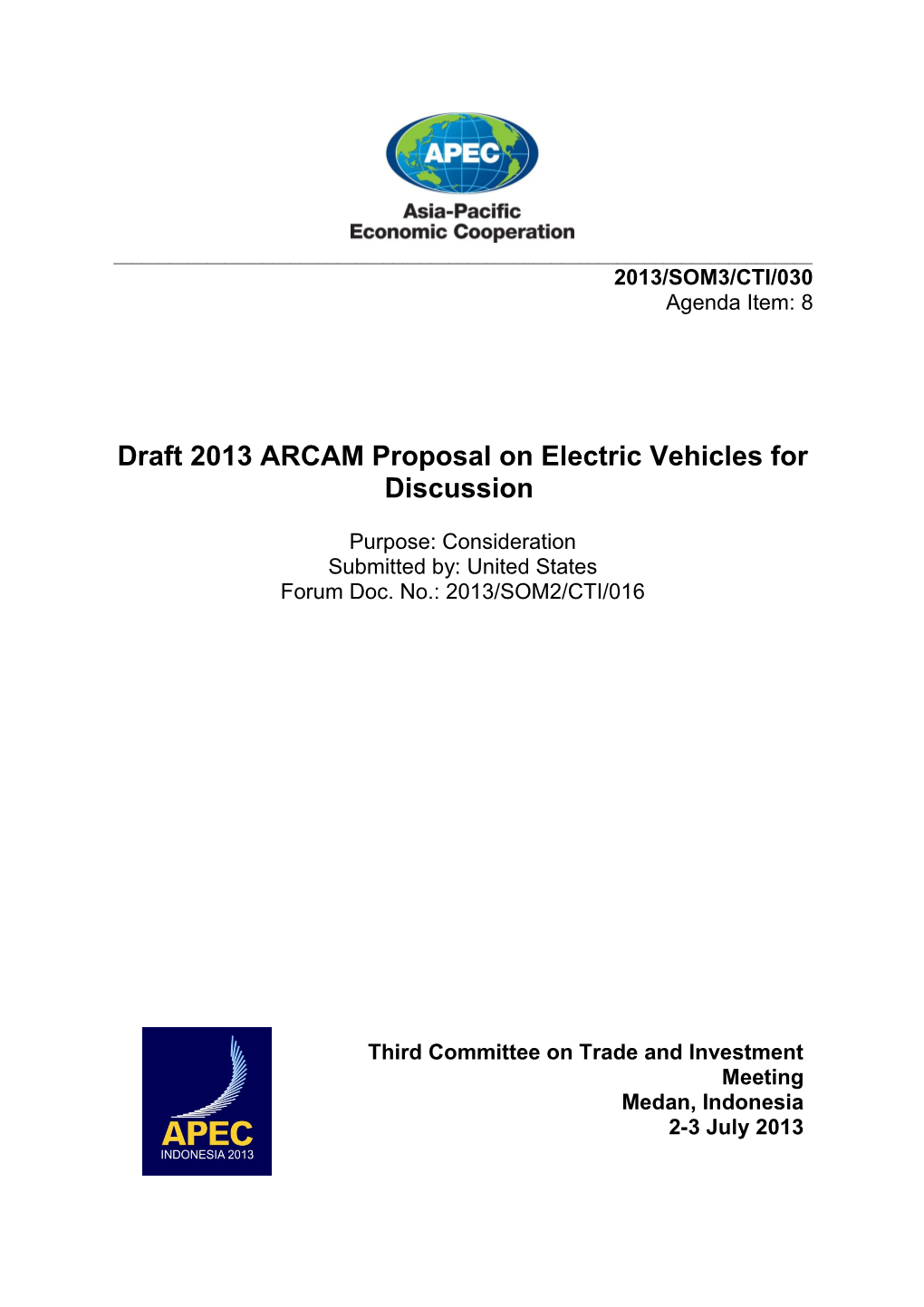______
2013/SOM3/CTI/030
Agenda Item: 8
Draft 2013 ARCAM Proposal on Electric Vehicles for Discussion
Purpose: Consideration
Submitted by: United States
Forum Doc. No.: 2013/SOM2/CTI/016
/ Third Committee on Trade and Investment MeetingMedan, Indonesia2-3 July 2013
APEC Regulatory Cooperation Advancement Mechanism (ARCAM)
2013 Proposal on Electric Vehicles
Submitted by: the United States
APEC Leaders and Ministers have instructed APEC to enhance good regulatory practices and regulatory cooperation, and facilitate trade and investment in environmentally friendly technologies, reducing barriers to trade in such goods. The CTI created the ARCAM dialogue with an aim to prevent and address unnecessary technical barriers to trade by bringing regulators, trade officials, industry representatives, and other key stakeholders together to discuss a specific issue. This year, we propose that the ARCAM dialogue focus onelectric vehicles as the next emerging issue for cooperative discussion.
Electric vehicles, or EVs, and smart grid programs are important components in the region’s transition to low-carbon economies and reduced dependence on fossil fuels. Increasing use of EVs in APEC economies would helpadvance APEC Leaders’ 2010 commitment to help “establish a low-carbon society in which we maintain economic growth while protecting the environment.” Given that EVs remain an emerging segment of the regional automotive industry, an ARCAM dialogue on electric vehicles in 2013-2014 would offer a timely forum for advancing regulatory cooperation.
The market potential for increased trade among APEC economies in electric vehicles over the next several years ispromising. While still relatively new to market, highway capable plug-in vehicles have seen significant sales gains. Some researchers forecast plug-in sales to reach 3.8 million vehicles per year by 2020 with growth of nearly 40 percent annually, versus only 2 percent growth in the automotive sector as a whole (note: growth potential will heavily depend on charging infrastructure). Since manufacturers are adding many additional models to the market in the interim, it is possible for the segment to see significant growth along those lines.In the United States alone, the selection of available highway capable plug-in and electric models available for public sale grew roughly 400 percent in 2012, and manufacturers have announced new models due in the coming years. If divergent EV regulations arise in APEC economies, it could have a significant impact on trade and investment flows in the region.
Large-scale capital investment for private sector deployment of EV over the next several years will depend on the ability of consumers to charge conveniently, safely and securely – anywhere, anytime – and deal with service providers without undue effort. This will require close connectivity between automotive manufacturers, standards developers, utility industries, consumers and regulatory bodies. It is in our collective interest as APEC economies to coordinate regulatory efforts on this important topic; and the ARCAM dialogue is an excellent and timely mechanism to employ towards meeting the goals set forth by APEC Leaders and Minister on regional economic integration and sustainable growth.
The international community is making a concerted effort to prevent technical differences from curtailing intra-national andinternational cross-border travel and trade while also addressing the burgeoning needs of the plug-in market. Countries such as the United States, EU, China, Japan, and Korea have held numerous exchanges on standards and technical regulations to find common ground, and work is underway in multilateral fora such as the UN’s World Forum for Harmonization of Vehicle Regulations (WP.29) as well as APEC, which hosted a 2012 Electric Vehicle Connectivity Workshop last year in Wellington, Australia.A number of emerging technical issues have been raised by industry and government stakeholders, including: battery safety (including storage); packaging and transport of batteries and battery waste; vehicle safety including audible warning systems, labelling, emergency disconnects, and safe battery discharging; vehicle charging issues such as coupler, wireless, and battery swapping safety and interoperability; power supply issues including communications, bi-directional supply, sub-metering, access control and roaming. The ARCAM dialogue will examine and discuss the work underway in the fora noted here, and will seek to identify areas for regulatory collaboration.
An ARCAM dialogue on electric vehicles would bringtogether trade officials, regulators, standards developers, utilities providers, and other key stakeholders from the region to discusseconomies’ plans fornew regulations, or modifications to existing regulations, that would significantly impact and promote the EV industry and use of EVs, and therefore our capacity for increased regional trade and investment.
Where appropriate, this dialogue can build from discussions and recommendations from the 2011 ARCAM Smart Grid Interoperability Standards Dialogue.[1] The CTI will seek input from other relevant fora, such as the Subcommittee on Standards and Conformance (SCSC), the Automotive Dialogue (AD), and theAPEC Energy Working Group’s Expert Group for New and Renewable Energy Technologies (ENGRET), which is currently undertaking technical work to promote standardization of charging infrastructure and harmonized communications protocols for EVs.
[1]Recommendations from the 2011 ARCAM dialogue include to “encourage the development of economy-wide frameworks for standardization that reflect domestic market needs and are consistent with established reference architectures; promote coordination across domains; and enable interoperability at the interfaces critical to plug and play technologies (such as those relating to advanced metering infrastructure, consumer demand response, electric vehicle infrastructure, integration of renewable energy sources and distributed generation and storage devices).”
